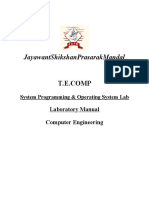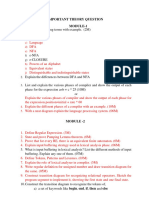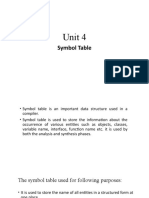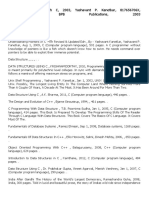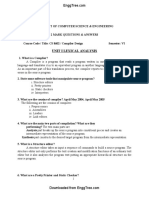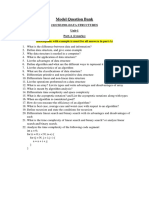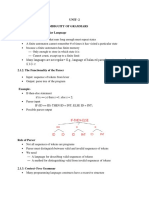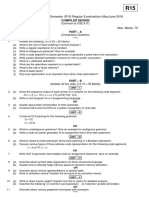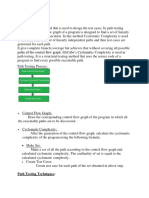0 ratings0% found this document useful (0 votes) 205 views48 pagesCompiler Design
Copyright
© © All Rights Reserved
We take content rights seriously. If you suspect this is your content,
claim it here.
Available Formats
Download as PDF or read online on Scribd
May-2014
Principles of Compiler Design
Semester - VI (CSE)
Time : Three Hours] [Maximum : 100 Marks
Answer ALL Questions
PART A - (10 x 2 = 20 Marks)
State any two reasons as to why phases of compiler should be grouped.
__ (Refer Two Marks Q.15 of Chapter - 1)
Why is buffering used in lexical analysis ? What are the commonly used buffering
methods ? (Refer Two Marks Q.17 of Chapter - 2)\
Define lexeme. (Refer Two Marks Q.18 of Chapter - 2)
‘Compare the feature of DFA and NFA.
(Refer Two Marks Q.19 of Chapter - 2)
What és the significance of intermediate code ?
(Refer Two Marks Q.13 of Chapter - 6)
Write the various three address code form of intermediate code ?
(Refer Two Marks Q.14 of Chapter - 6)
m0)
D table. (Refer Two Marks Q.7 of Chapter - 5)
techniques in loop optimization.
0 Marks Q.26 of Chapter - 8)
| mean by cross-compiler ? (Refer Two Marks Q.11 of Chapter - 1)
‘you represent the dummy blocks with no statements indicated in global
lysis ? (Refer Two Marks Q.27 of Chapter - 8)
_ PART B - (5 x 16 = 80 Marks)
terms : compiler, interpreter, translator ‘and differentiate
2 ke [6]
token and patter. (Refer section 22.1) {61
ln? eter sstion 23) @ @ eta�Consider the following grammar
5 AS |b
SA | @ i ’
Bin the SLR parse table for the grammar. Show the actions of the parser for
the input string “abab". (Refer example 3.9.9 and 3.9.10) {16
OR
ib) i) What isan ambiguous grammar ? Is the following grammar ambiguous ? Prove
E>E+E|E*E | CE) | id. The grammar should be moved to the next Hine,
centered. (Refer section 3.5) [8]
i) Draw NFA for the regular expression ab*/ab. (Refer example 2.1316) [6]
43 a) How would you convert the following into intermediate code ? Give a suitable
example.
i) Assignment statements (Refer section 6.6) {8}
ii) Case statements (Refer section 6.9) [3]
OR
b) i) Write notes on backpatching. (Refer section 6.11) [3]
ii) Explain the sequence of stack allocation processes for a function call.
(Refer section 5.4.2) Is]
14 a) Discuss the various issues in code generation with examples. (Refer section 7.4)
tél
OR
Define a directed acyclic graph. Construct a DAG and write the sequence of
instructions for the expression a + a * (b~c) + (b-c) *d.
(Refer section 7.11.8) le)
Discuss in detail the process of optimization of basic blocks. Give an example.
"(Refer section 8.5) v Sa 1
fe)
OR
at is data flow analysis ? Explain data flow abstraction with examples.
r section 8,8) tel
Q00
L PUBLICATIONS” An up thrust for knowledge���yo suonson) SHEN OAL, wloI} 9'D JO JOMSUE
(9 saideyp Jo suonsand) HEN OAL
sappy ¢98enSuey aimpouuzyiy Susjuaszides fo. shom
(c- saideyp 30
suey om mors <1 Jo rMsue royoy) “souiaxa] pun swayed ‘suRjo} 2ueC
suonson ‘Ty Jomsuy
‘EW OT # ume]�Explain with exampre, uveres one
patching with an example. (Refer section 6.11) ia
ii) Explain about back
OR
4B) B Write down the translation scheme to generate three address code for the
assignment statement. (Refer section 6.6) i
ig Hows wouta you generate intermediate code for the flow of control statements?
(Refer section 6.11.2) oN
@.14 a) i) Discuss briefly about simple code generation algorithm. (Refer section 7) {s]
G) For the fom graph: shown teow, crite the three address statements a
ct the DAG. ‘��December-2012
sign
Principles of Compiler De:
Semester - VI (CSE)
+: Three hours] [Maximum : 100 Marks
nan ‘Answer ALL questions
PART A - (10x 2 = 20 Marks)
Qt Wiite the regular expressions for identifier and number (R
from Two Marks Questions of Chapter - 2)
2 tree, (Refer answer of 0.16 fro
fefer answer of Q.14
Compare syntax tree and pars m Two Marks
Questions of Chapter - 3) a
Write the rue to eliminate lft recursion im. STamnlr (Refer answer of Q.17
from Two Marks Questions of Chapter - 3)
Mention the role of semantic analysis. (Refer answer ©
Questions of Chapter - 4) y
£ Q.4 from Two Marks
=p" —c+b*-c. (Refer example 62.2)
Draw syntax tree for the expression
Q.6 from Two Marks Questions of
Define backpatching. (Refer answer of
Chapter - 6)
List the advantage of DAG. (Refer answer
Questions of Chapter - 7)
What are the uses of register and address descriptors in code generation ? (Refer
answer of 0.17 from Two Marks Questions of Chapter - 7)
Define live variable. (Refer answer of Q.22 from T i
eo Q.22 from Two Marks Questions of
What is data flow analysis? (Refer answer of
% f Q.18 fro ks
‘Questions of Chapter - 8) i aN
PART B - (5 x 16 = 80 Marks)
in detail about the phases of comy
ipiler and translate tl
= init + rate'60, (Refer section 1,4) OS a el
OR
NFA and DFA. Construct a DFA di
(efnb'). (Refer example Pye on peers a
of Q.16 from Two Marks�Cea. saa.
‘of Compiler Design S-13
Solved Paper December-2012
2 2) Construct non recursive predictive parsing table for the following grammar,
~ ESE or E\E and E\not E| (E)|0|1. (Refer example 3.7.11) 6]
OR
b) Construct SLR parsing table for the grammar lel
ESEsT|T
T+ TF|F
F>F*|a|b (Refer example 3.9.5)
j) Translate the following switch statement into intermediate code. [8]
Switch E
begin
case V1 : S1
case V2 : S2
case Vn-1 : Sn-1
default : Sn
end (Refer section 6.9)
1) Generate three address code for the boolean expression a
What are the types of three address statements ?
(Refer Two Marks Q.3 of Chapter - 6)�process. W:
the construction of lexical analyzer.
| jokens: In this chapter: we owas
\ fe will also discuss the method of identifying tokens trom svuree:progran
Pally we will lea a tool, LEX which automates
) EE] Role of Lexical Analyzer
Explain in detail the role Gidea onayser ith possible error recat actions
oa
) > Dae the role of lesa! onober in dea _ ia
Lexical analyzer is the first phase of compiler. The lexical analyzer reads the input
source program from left to right one character at a time and generates the sequence of
Ly tokens. Each token is a single Jogical cohesive unit such as identifier, keywords,
to determine the syntax of the source
operators and punctuation marks, Then the parser
ole of levical analyzer in the’ process of compuaton�\/ $4240] Jo uoneowloeds EFA
/+ Paureos 0} sey indur Sururewior [HS «/
“+g
este
I! ages eqeuruue3, 43 ae�string over Y= (al.
has to built for the language
L = {a, aa, aaa, ..
| This set indicates that there is no null string. So we can write,
The + is called positive closure.
in with
; (SEIZED Desion regular expression for the language o containing all the strings
| ‘any number of a’s and b's. g me sia
lution : The RE. will be
RE. -= (a+b)
The set for this RE will be -
L = {ea�errs
“Suns yynu & ydaoxo sq pue se
faa gum uowssaidxo zener Sy
z ST RHRAS Trad 241 sdooxa 5,9 pun 5,» fo soquima Ras
imjuoo aBynSuvy ay sof uosssaadxa avjnSou v jansysuoy
i
5 ‘Biseq v09di00 70 Serge
2o4.
@amncs On>
Sam 103 7G) SHS -�x raged nd 1
“aden wos spe ne 70 FAHY ED
ia
(4-08 95.) admeg fo soge> & RENIN BEY
-ejeoine sy fo yun ap puns
copes nwo on = foil mUOIN aH 20(NSA) SUNPUHY HES AML PV
“aud mekqou omy ae Seve suoRDUNY YO OE LS AS
suopouny oon 30 sme yc oy pds sap (eu
sag hogs gnu pes or Pailbp 1 vowpuny © “VAN JP me Xow sa Sy am
ag (WAN
oon ayes >peuTUAnOp-UON wo LH} ans UNH SET
Seether any eur aa of esome vy soeaade aeeRay asap oad AMS
‘spy Bapuodsnns
soy ang ase events seat pur s9ynq andur mo peek S| LID AL SEAMS
-ayng yy wr nda yas siaseue (EIT�Principles of Compiler Design 2-24
Lexical Analysis
aa eee ‘ransition table can be read as : when current state is Sy, on input 0
ee State will be Sz and on input 1 the next state will be S;. The arrow marked to
So indicates that it is a start state and circle marked to S, indicates that it is a final
state.
CRU
Sake FA which accepts odd number of 1's and any number of 0's.
Solution : In the problem statement, it is indicated that there will be a state which is
meant for odd number of 1's and that will be the final state. There is no condition on
number of 0's.
At the start if we read input 1 then we will go to
state S, which is a final state as we have read odd
number of 1's. There can be any number of zeros at
any state and therefore the self loop is applied to
state S) as well as to state S,. For example, if the
input is 10101101, in this string there are any
number of zeros but odd number of ones. The
machine will derive this input as follows -
Fig. 2.8.4(a)
1__Input ends here
pein oputenshe
jn Which isa final state�Sep wotsen van a0 oe EES
== GEE
wee ec A Hoag�go sat state Setinion ws «= sere
Fis a set of al states such that Pe ‘The €- closure (P) isa set o
‘e-transitions such that
I) e= closure (p) = p where
i) there exists ¢- closure
Find © cl
© closure (qo) = {4
© closure (q3) = (4
4 closure (q2) = (9
EEREES conversion of nFf
this method we ty to 1
dl out all the © tar
closure {4,} where g)�w
os
7
vA
Lexical Anaiysis
nips of Compiler Design
8 (qo,tbbee)
8(41,bbce)
F 8(qi, bec)
F 8(qi, cc)
F B(ar-ecc)
£8 2,0)
F 8(a2,0)
F 8(a2,e)
‘Thus we reach to accept state,
g
after scanning the complete input string,
Definition of ¢ - closure
Thee closure (p) is a set ofall states which are reachable
transitions such that
4) €- closure (p) = p where p € Q.
Jf there exists €- closure () = {q) and 8 (4.2)
=r then e = closure (p) = {qn
WED i ie re ftsng WEA ein c
from state pon
iy
palition:
© closure (qo)
= {90-41,
& dlosure (91) = 4,
a} means sel state + ¢ - reachable tate,
a} means qi a self tate and a is a state
obtained from 4) with ¢ input
# dlnure (42) = {a3}
BIDET conversion of NFA with © to NFA without ¢
Jn this method we remove al
Wipe “NO We ty to remove ll thee transitions from given NFA. The method
L Rnd out an
Fcos�Srey
“sy principles of Compiler Desion 2-31 Lexical Analysis.
= + 8 (qo,ebbcc)
W + 8(q1/bbec)
F 8(a1,bec)
F 8(q41,¢0)
8(a1 ec)
F 8 (a2,¢0)
F 842-9)
F 8(42-€)
Thus we reach to accept state, after scanning the complete input string.
Definition of e - closure
The e- closure (p) is a set of all states which are reachable from state p on
¢ -transitions such that :
i) e - closure (p) = p where pe Q.
ii) If there exists € - closure (p) = {q} and 5 (q£) = r then € - closure (p) = (q, 1)-
Find © Giosiire for the following NFA with &. (i)
[ktrns atk et dein
E
Fig. 2.10.3
Postion :
e - closure (qo) = {40/41/42} means self state + € - reachable states.
There
e cs.
e- closure (41) = {41/42} means q; is a self state and q> is a state
obtained from q, with € input.
€- closure (q2) = {2}
Conversion of NFA with ¢ to NFA without «
In this method we try to remove all the € transitions from given NFA. The method
will be
"1 Find out all the € transitions from each state from Q. That will be called as
| €-closure {q;} where qj € Q.
‘TECHNICAL PUBLICATIONS” An up thrust for knowledge�. ~ osm vacate € = clostite
Se (41) and € - closure (q3) contains final
Alternate method
This is direct method to convert NFA with ¢ to FA
without e.�ty 20j VIN
p=
yap sn i714 = 2 BU
PR aes erPl
yonzjsuo> pur 2
an sed
“ge of sleanto van mH oo
a Gna
veymnna say yeambo van uo 30} yan aze prsHOD ASN) SAL
sere Oy�analyzer and syntax analyzers,
us first go for un section
procedure section
faction;}
{action,}�tants can be done. Some
4 to LEX
ee i tion declaration of variable const
« In the declaration sec a
Ree regular definitions ca" als0 ve writen in ti section. THe regular definitions
Rone eseally components of BUT expressions appearing i" the rule section: |
pet Ste ale section consists of TRL pressions with assaaied AHO
cen in the form a5 ~
translation rules can be &
R, {action}
Ry, {actiong}
R, _{action,}
‘and each action, is a program fragment
These actions
gular expression
Where each R; is 2 Te
be taken for corres}
describing what action is to
ee by piece of C code.
Te And third section is a auxiliary procedure section in which all the required
procedures are defined. Sometimes these procedures are required by the actions in
rule section.
The lexical analyzer or scan
ponding regular expression.
er works in co-ordination with parser. When activated
parser, the lexical analyzer begins reading its remaining input, character by
= When the string is matched with one of the regular
get executed and this action, returns
er at a tim
sR, then corresponding action, will
to the parser.�Principles of Compiler Design
TW FI’
TOT*F|F STS le
F3() | id = F3@) | id
fp cxancle 371} Consider the following grammar
\ A ABd|Aala
B- Be\b
| remove left recursion.
| Solution : Consider the rule,
A ABd|Aala
AsAalB
We map this grammar with the rule
Je a
This can be eliminated by re-writing the production 74
ara Bal?
+ ty
A Aggie
NAN ee
Al Ag Al ot BdA’
A’ => 8 A eee
For Aa Aala
tees
A AaB
“This left recursion can be eliminated a8 -
yA > BA’ A > ad’
Mey APF oNioz) A’ > aA!
NM = ©
ASABd|Aala => A > aA’
A’ + BdA‘|aA’
Woe
B > Be|b
grammar with the rule A — Ao. |B .
"TECHNICAL PUBLICATIONS”. An up thust for knowledge�: is left factored then it becomes suitable for the use. Basically left
Be cn dan al wc of he (wo seas OS
rnon-terminal. By left ractoring we may be able to rewrite the production
q ok unt enough oe input ssn to mae he SE
183| 082
i Frei not possible fr us fo take a decision whether to choose Bt
d Tr such a situation the above grammar can be let factored a
IS | iBtSeS | a�PDET|T
—x
The left factored grammar becomes, i map the above rule as
S = iBtss'|a
Sse soi
E>b AKG
a Knee
Eliminate the ion from the following grammar»
AE A> AclAnd|ba|e. i Car
Soittion + To liminate left rerursion we have a rule : when A= /A G/B rule th
convert it to 7 ee ©
bons Ee
A’ saa 2 TOT*F|F
map the above rule as
Tors
PPM
Aha
) | id is not a left recursive
after eliminating left recursion.
Tr�> SE A ean 208
Syntax a, ony)
is
principles of 00 = 3-57
<<
| 3.3] Bottom-up Parsing a
What do you mean by handl
Define handle.
a for each of top down parser and bottom up parser.
In this section, we will discuss "How an i
compilers, the task is done by a program «:
sither it checks the input string completely
‘on syntactically input strings. In bottom-up es ee
fist and we try to reduce this string with the o obtain the
a sat symbol |The process of parsing halts su react��hee
Note a�"design a DFA for above set of items as follows
ie DFA every state is final state, The state Ip is initial state, Note that the
Viable prefixes,
TECHNICAL PUBLICATIONS”. An up tt for Anowcge��opel
Pn aac
unum spp sn Bund
pop eyeipaurt 12�can be written a
pd ia
ao
sed [eo
operands
ite of polish notation
hich is used using post
A yeren pons notalhy wl
There is
representation
Consider that t
ath +a,
he input expression 18 =
then the required posix form is -
Gastric syntax
spilas ee td posix notation for the foil
ow
ing expres
sion
MiGHeo)T d-e/ (+8)
Sahin : Syntax Tree |
97) Nd-e/tep
1d-e/(t+g)
Hg)�Now backward substituting the values of temporary var�Sean, copter DOS fone Code con
oe
ifch=1 goto L1
eo ifch=2 goto L2
Tate! ey, ti=arb
ao e eat
| 6 goto Last
ee ae
[ne a
| oat
ge ue
Ia intermedi code for ‘te eli Sle Sema ASRS RTD
required syntax directed translation scheme
Dit (a > 2b)
f x=a+d
& else
x=a-b
Where a & x are of real and b of int type data
i int a,b;
foat ¢
a=10;
‘switch (a)
{
caso 10:0
case 20: ¢ =
wah } | ApriUMav-08. Marks 16 |
#H)ifa>b goto Li
‘Goto L2-
u: {1 := inttoreal b
=a+tl
2
{1 inttoreal b
Qiza-tl
x=o
TEHNCAL PUBLICATIONS”. An wp rus er krownige�����is Ug to ply i
nN basic block = Dae
Pe ante Constructed fo, thar Peleg
a Pr, vttled by ‘dentition or yy,
peat recor T-values,
le nodes store 9
ter
in
ee Values,
id flow gra
DAG an
The
PAS are tg aie
meee’ "Presented by Dag
flow
the
jc block,
basic:
Tepr
“ASE each Nog
Clg MU B
Bra
Ey Consider��paw
ee ON
"pan tn ate on be Hc flo�a rh toes ;
Ho Soompltn te = compa of ern
on tne the vale op
Ts dove dng ea i PEN BY 316 Ad by 5 then
‘common sub expression t=
ue of iis not been changes from
Teen���







